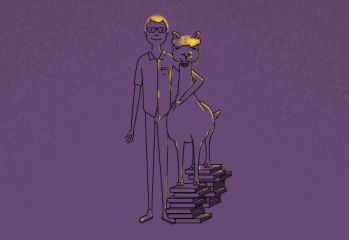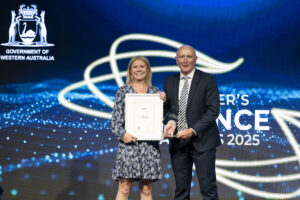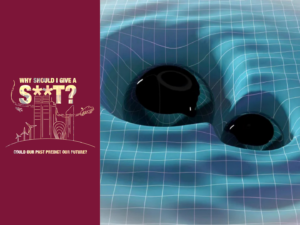Kids are stomping around on bean bags, adults are chatting away and several ominous looking crates labelled ‘reptiles’ sit on the stage.
I’m at an event for Indigenous mentor and author Corey Tutt’s latest book Caution! This Book Contains Deadly Reptiles.
He starts the event by reciting Eminem lyrics – an interesting choice for an audience of kids.
A yarn about crocodiles and a short introduction follows.
It includes the standard information. He’s a proud Kamilaroi man and the Founder and CEO of DeadlyScience.
There’s quite a contrast between Corey and CEO Corey. One chats with kids about reptiles, the other is deeply vulnerable and consistently drops F bombs.
“JUST A NORMAL GUY”
Corey is easily likeable. He loves a yarn and is quick to share stories of love and loss.
He refers to himself as “rough around the edges”.
“I’m just a normal guy,” says Corey. “I play footy, I drink beer … I’m not a celebrity.”
He’s full of interesting yarns about his life.
Caption: Corey and Josh presenting at his event Caution! This Event Contains Deadly Reptiles for The Wheeler Centre Kids
Credit: Mandy Wu
He met Barack Obama and has chickens named after politicians (Henny Wong is my personal favourite).
He has even worked in a school with a crocodile occupying the basketball court.
Hidden beneath Corey’s warmth and quirks are some dark tales from his life.
He’s received threats online and in person, had weird love letters written to him and endured family loss.
In spite of these dark times and experiences, he is always fighting for better outcomes for Aboriginal kids.
“I finished school in Year 10,” says Corey.
“I’m not talented. I can’t sing. I can’t dance. I’m not that smart. I make up for it all in effort.”
Effort is right. He built DeadlyScience from nothing to become Australia’s first and largest STEM facilitator for Aboriginal kids.
He has the same passion for STEM equity that Robert Irwin has for crocodiles. (That is to say, a lot.)
AN OAM AND A GQ MODEL
Corey started DeadlyScience in 2018 and had a very fast rise to the top.
Caption: DeadlyScience began by sending books to remote communities
Credit: Supplied Corey Tutt
He has received many accolades for his work, including an Order of Australia Medal.
Since its inception, DeadlyScience has reached over 34,000 students at more than 1100 schools.
In the beginning, Corey was sending out science books to schools in remote areas.
“I spent hundreds of thousands of dollars posting books to remote Aboriginal communities,” he says.
To try to make ends meet, he said yes to every opportunity that came his way. This included two modelling stints – one for GQ Magazine Australia and one for Dell.
DeadlyScience receives no government funding, so Corey has worked hard to create business partnerships.
Caption: DeadlyScience has strong connections to the F1 community – (L-R) Logan Sargeant, Vince Scott (DeadlyScience Senior Program Manager) and Alex Albon
Credit: Supplied Corey Tutt
Given his affinity for posting resources, his partnership deal with Australia Post is the one he’s “most proud of”.
TWO FOR ONE DEAL
Corey’s mission is more than just improving STEM equity for Aboriginal kids.
He’s working to create justice reform, improve the health of Aboriginal communities and strengthen environmental outcomes.
DeadlyScience runs a program called Kickin’ It, which was created by nine boys inside the Acmena Youth Justice Centre.
Corey guided these kids to create their own program.
It’s now been rolled out across 50 juvenile justice centres across Australia to engage other young people in STEM.
Caption: Vince, Corey and crew ready to ship out Kickin’ It kits.
Credit: Supplied Corey Tutt
Another program is called Deadly Labs. It was created with Garawa Elders and mob to tackle rheumatic heart disease, which is more prevalent in Indigenous people.
Rheumatic heart disease can be prevented with proper hygiene, but soap can be expensive in remote communities.
The program is tailored to each mob, using local medicinal plants from each area to create soap.
Making soap under the guise of a science experiment is increasing STEM equity and preventing rheumatic heart disease.
The entire team at DeadlyScience are working to solve real-world problems.
“I’m over marshmallow engineering and pasta bridges. Get the kids out there doing applied, practical stuff,” says Corey.
BRIGHT FUTURES
There’s a long way to go to achieve STEM equity for Aboriginal youth.
“It’s not the kids that need to change, it’s the system,” Corey says.
He is doing his best to change the system by creating positive outcomes for kids and mob within STEM and outside of it.
DeadlyScience has a bright future, but what is the end goal?
“I want it to be obsolete,” says Corey. “I want it to not be needed because there is STEM equity in Australia.”
It’s unlikely this will come in Corey’s lifetime, but if by some miracle it does, the first thing he plans to do is go fishing and enjoy a beer.









